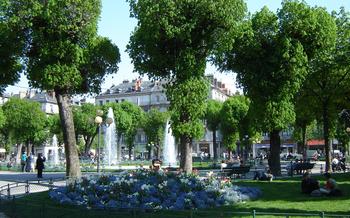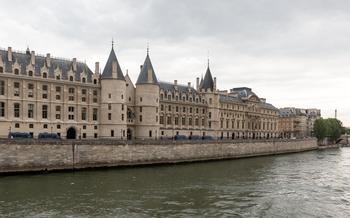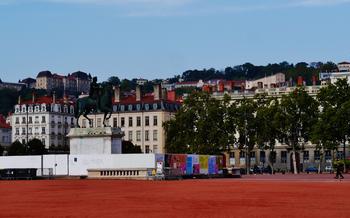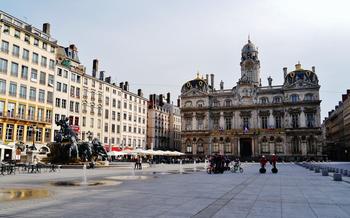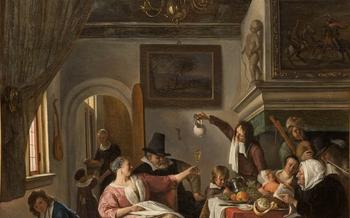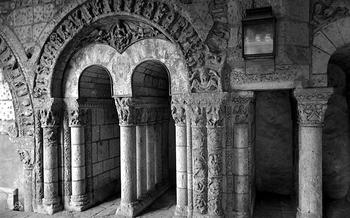
Hôtel de Lesdiguières (Lesdiguières Mansion)
- Hôtel de Lesdiguières (Lesdiguières Mansion)
- Location and Getting There
- Hours of Operation and Admission Fees
- Guided Tours
- Exhibits and Collections
- Architecture and Design
- Historical Significance
- Famous Residents
- Current Use as a Museum
- Events and Activities
- Tips for Visitors
- Nearby Attractions
- Photography and Social Media
- Insider Tip
Hôtel de Lesdiguières (Lesdiguières Mansion)
Historical Significance
The Hôtel de Lesdiguières, also known as the Lesdiguières Mansion, is a historical landmark in Grenoble, France. Built in the 16th century, this Renaissance-style mansion served as the residence of François de Bonne, the Duke of Lesdiguières, a prominent figure in French history. Lesdiguières played a crucial role during the French Wars of Religion, leading Protestant forces to victory in several battles. His success and influence made him a respected military leader and a trusted advisor to King Henry IV. The mansion, therefore, holds great historical significance as the home of a man who left an enduring mark on France's political and religious landscape.
Architectural Features
The Hôtel de Lesdiguières is renowned for its exquisite architectural features. Its Renaissance-style facade showcases intricate carvings, decorative pilasters, and ornate balconies that exemplify the elegance and artistry of the period. The mansion's courtyard, with its elegant arcades and a central fountain, further adds to its charm and grandeur. Inside, visitors can admire the well-preserved grand staircase, adorned with elaborate ironwork, and the beautifully decorated rooms that once hosted lavish receptions and meetings.
Notable Previous Occupants
Aside from the Duke of Lesdiguières, the mansion has been home to several notable figures throughout history. In the 17th century, it was acquired by the Créqui family, who played a prominent role in French politics and military affairs. Later, it became the property of the Le Fort family, whose members held important positions in the royal court. Each family left its mark on the mansion, contributing to its rich history and legacy.
Current Use as a Museum
Today, the Hôtel de Lesdiguières serves as a museum dedicated to the history of Grenoble and the Dauphiné region. It houses a vast collection of artifacts, paintings, and documents that provide visitors with a glimpse into the city's past. The museum's exhibits cover various aspects of Grenoble's history, from its Roman origins to its role as a center of Protestantism during the Renaissance. Through interactive displays and educational programs, the museum aims to engage visitors and foster a deeper understanding of the city's heritage.
Location and Getting There
The Hôtel de Lesdiguières is situated in the heart of Grenoble's historic city center, at 14 Rue Saint-Laurent. Its prime location makes it easily accessible by various means of transportation.
To reach the mansion by public transport, visitors can take the tram lines A or B and get off at the "Hubert Dubedout - Maison du Tourisme" stop, which is just a short walk away. Alternatively, several bus lines, including lines 12, 13, 14, 16, and 54, stop nearby, offering convenient connections from different parts of the city.
For those arriving by car, limited street parking is available in the surrounding area, but it's advisable to use one of the nearby parking garages for a more reliable option. The closest parking garage is the "Parking Les Halles," located just a few minutes walk from the Hôtel de Lesdiguières.
If you prefer to explore the city on foot, the mansion is within easy walking distance from several notable landmarks. From the Place Grenette, the city's main square, it takes approximately 10 minutes to reach the Hôtel de Lesdiguières, passing by charming streets and historical buildings along the way.
Exact address: 14 Rue Saint-Laurent, 38000 Grenoble, France.
Hours of Operation and Admission Fees
The Hôtel de Lesdiguières welcomes visitors from Tuesday to Sunday, offering ample opportunities to explore its captivating exhibits. The museum's regular hours are from 10:00 am to 6:00 pm, providing ample time to delve into the mansion's rich history and collections. During the summer months, from July to September, the museum extends its hours, staying open until 7:00 pm, allowing visitors to take advantage of the longer daylight hours.
Admission fees vary depending on the visitor's age and status. Adults are charged a standard fee, while children under the age of 18 and students with valid identification can enjoy a discounted rate. Seniors over the age of 65 are also eligible for a reduced admission price. Additionally, the museum offers free admission to children under the age of 6, providing an excellent opportunity for families to experience the mansion's wonders together.
To enhance the visitor experience, the museum offers a variety of guided tours. These tours provide in-depth insights into the mansion's history, architecture, and collections, allowing visitors to delve deeper into the stories behind the exhibits. Guided tours are available in multiple languages, ensuring that international visitors can also fully appreciate the mansion's significance.
The cost of guided tours varies depending on the group size and the language of the tour. Visitors can book guided tours in advance by contacting the museum directly or through the online booking system. The museum's website provides detailed information on tour availability, languages offered, and booking procedures, ensuring a smooth and enjoyable experience for all visitors.
Guided Tours
The Hôtel de Lesdiguières offers guided tours that provide a deeper insight into the mansion's history, architecture, and collections. These tours are led by knowledgeable guides who share fascinating stories and anecdotes that bring the mansion to life. Tours are available in French and English, and private tours can be arranged for groups of 10 or more.
To book a guided tour, you can either reserve online through the museum's website or contact the museum directly by phone or email. The cost of a guided tour is 5 euros for adults, 3 euros for children, and 4 euros for seniors. Discounted rates are available for groups of 10 or more.
Guided tours are an excellent way to learn more about the Hôtel de Lesdiguières and its significance. The guides are passionate about the mansion and its history, and they provide a wealth of information that you might not be able to find on your own. Whether you are a history buff, an architecture enthusiast, or simply someone who wants to learn more about Grenoble, a guided tour of the Hôtel de Lesdiguières is a worthwhile experience.
Exhibits and Collections
The Hôtel de Lesdiguières houses a diverse collection of artifacts and exhibits that tell the story of Grenoble and the Lesdiguières family. The museum's permanent collection includes paintings, sculptures, furniture, and decorative arts from the 16th to 19th centuries. Highlights of the collection include:
- A portrait of François de Bonne, Duc de Lesdiguières, by the renowned artist Pierre Paul Rubens.
- A collection of 17th-century tapestries depicting scenes from the life of Hercules.
- A set of porcelain dinnerware from the 18th century, once owned by the Lesdiguières family.
- A scale model of the city of Grenoble from the 19th century, providing a glimpse into the city's past.
In addition to its permanent collection, the Hôtel de Lesdiguières also hosts temporary exhibits and rotating displays. These exhibits explore various aspects of Grenoble's history and culture, such as the city's role in the French Revolution or the development of the local silk industry.
The museum also offers educational programs and workshops for visitors of all ages. These programs provide an opportunity to learn more about the history of Grenoble and the Lesdiguières family, as well as the museum's collections.
Architecture and Design
The Hôtel de Lesdiguières showcases a striking blend of Renaissance and Gothic architectural styles, reflecting the transition between these two eras in French history. Its imposing facade features intricate stone carvings, including the Lesdiguières coat of arms and decorative motifs. The mansion's courtyard, a highlight of its design, boasts an elegant Renaissance-style arcade and a central fountain, creating a harmonious and inviting space.
The building's history is evident in its architectural details. Constructed in the 16th century, the mansion underwent several renovations and expansions over the years. The most significant alteration was carried out in the 17th century when the Gothic-style tower was added, providing a distinctive landmark for the city. This tower, with its pointed roof and intricate carvings, stands as a testament to the evolving architectural tastes of the time.
Throughout the mansion, visitors can admire the skillful craftsmanship and attention to detail that characterize Renaissance and Gothic architecture. The grand staircase, adorned with intricate ironwork, leads to the upper floors, where visitors can explore the mansion's numerous rooms, each with its own unique charm and architectural features.
Historical Significance
The Hôtel de Lesdiguières holds immense historical significance, deeply intertwined with the illustrious Lesdiguières family, who played a pivotal role in shaping the course of French history. François de Bonne, the first Duc de Lesdiguières, was a distinguished military leader and statesman, revered for his strategic prowess and unwavering loyalty to the French crown. His astute leadership during the French Wars of Religion earned him widespread recognition and the title of Constable of France, the highest military rank in the kingdom.
Throughout the centuries, the mansion served as a prominent gathering place for influential figures, hosting lavish receptions, political negotiations, and cultural events. Its walls bear witness to the intricate tapestry of French history, from the religious turmoil of the 16th century to the intellectual enlightenment of the 18th century. The mansion's enduring legacy is a testament to the Lesdiguières family's profound impact on French society, politics, and culture.
Famous Residents
The Hôtel de Lesdiguières has been home to a number of notable individuals throughout its history. Perhaps the most famous of these is François de Bonne, duc de Lesdiguières, a Huguenot military leader who played a key role in the French Wars of Religion. Lesdiguières was a skilled and successful commander, and his victories helped to secure the Protestant cause in France. He was also a close friend of King Henry IV, who made him a marshal of France in 159Lesdiguières' son, Charles, inherited the title of duc de Lesdiguières and continued to serve as a military commander. He was killed in battle in 1630, and the Hôtel de Lesdiguières passed to his daughter, Marie. Marie married Henri de La Tour d'Auvergne, vicomte de Turenne, another famous military leader. Turenne was one of the most successful generals of the Thirty Years' War, and his victories helped to establish France as the dominant power in Europe. The Hôtel de Lesdiguières remained in the Turenne family for several generations, and it was during this time that it was expanded and renovated. In the 18th century, the mansion was sold to the city of Grenoble, which used it as a town hall. In the 19th century, it was converted into a museum, and it has been open to the public ever since.
Current Use as a Museum
Currently, the Hôtel de Lesdiguières serves as a rich and informative museum, offering visitors a captivating journey into the annals of Grenoble's esteemed past. Its mission is to preserve and showcase the city's cultural and historical heritage through a diverse array of captivating exhibitions and educational programs. Within its hallowed halls, visitors can embark on an immersive voyage through time, delving into the region's fascinating stories, traditions, and artistic expressions. The museum's exhibits are meticulously curated, presenting a comprehensive narrative that encapsulates Grenoble's evolution from a humble settlement to a thriving metropolis. Through interactive displays, multimedia presentations, and engaging storytelling, the Hôtel de Lesdiguières brings Grenoble's rich history to life, ensuring that the legacy of this remarkable city continues to inspire and captivate generations to come.
Events and Activities
Throughout the year, the Hôtel de Lesdiguières hosts a variety of special events and activities that bring the mansion's history and collections to life. One of the most popular events is the annual "Fête de la Musique," which takes place on June 21st. During this festival, the mansion's courtyard is transformed into a stage for live music performances, dancing, and other festivities.
The mansion also hosts historical reenactments and demonstrations that allow visitors to experience life in Grenoble during the 17th and 18th centuries. These events often feature costumed actors, traditional crafts, and interactive displays. For those interested in learning more about the mansion's history and architecture, guided tours are available throughout the year. These tours are led by knowledgeable docents who share insights into the mansion's construction, its former occupants, and its role in Grenoble's history.
Visitors can also attend concerts, lectures, and workshops related to the mansion's history or collections. These events provide an opportunity for visitors to engage with the museum's staff and volunteers, learn more about the mansion's significance, and participate in hands-on activities.
Tips for Visitors
Budget at least two hours to explore the Hôtel de Lesdiguières thoroughly. The mansion's rich history, stunning architecture, and diverse exhibits warrant a leisurely visit to fully appreciate its significance.
Plan your visit for a weekday morning or early afternoon to avoid crowds. This will allow you to enjoy a quieter and more immersive experience, especially during the peak tourist season.
Consider bringing a camera to capture the mansion's architectural details, exhibits, and the picturesque courtyard. Flash photography is not permitted, but natural light provides ample illumination for capturing beautiful shots.
Be respectful of the museum's exhibits and other visitors. Maintain a low noise level, avoid touching or leaning on artifacts, and follow any specific instructions provided by the museum staff.
Take advantage of the museum's educational resources, such as guided tours, audio guides, or informational panels. These resources can enhance your understanding of the mansion's history and significance.
Nearby Attractions
The Hôtel de Lesdiguières is located in the heart of Grenoble's historic center, making it an ideal starting point for exploring the city's many other attractions. Within walking distance of the mansion, visitors can find a wealth of museums, historical sites, and landmarks.
Just a short stroll away is the Musée de Grenoble, which houses a renowned collection of art from the Middle Ages to the present day. Highlights of the collection include works by Caravaggio, Rubens, and Picasso.
Another nearby attraction is the Bastille, a former fortress that now offers stunning views of the city and the surrounding mountains. Visitors can take a cable car to the top of the Bastille or hike up the winding paths that lead to its summit.
For those interested in shopping, the pedestrianized streets of the city center offer a variety of boutiques, shops, and cafés. Visitors can find everything from local crafts and souvenirs to high-end fashion and gourmet delicacies.
To make the most of your visit, consider following a suggested itinerary or walking tour that includes the Hôtel de Lesdiguières and other nearby attractions. This will help you to maximize your time and experience all that Grenoble has to offer.
Photography and Social Media
Visitors are encouraged to capture their experiences at the Hôtel de Lesdiguières through photography and share them on social media using the hashtag #LesdiguieresMansion. The museum's social media accounts regularly feature user-generated content, showcasing the diverse perspectives and interpretations of visitors from around the world. By sharing their photos and stories, visitors become part of a vibrant online community that celebrates the history and beauty of this remarkable landmark.
In addition to capturing the grandeur of the mansion's architecture and exhibits, visitors are also encouraged to share their impressions and insights on the mansion's social and historical significance. Whether through stunning visuals or thoughtful commentary, visitors' contributions help to enrich the museum's online presence and create a dynamic dialogue around the mansion's enduring legacy.
For those seeking a more immersive experience, the museum offers photography workshops and guided tours that delve deeper into the art of capturing the mansion's unique character. These sessions provide participants with tips and techniques for creating compelling images that convey the essence of the mansion's history and atmosphere.
Insider Tip
As you wander through the Hôtel de Lesdiguières, keep an eye out for the hidden gems that reveal the mansion's rich history. One such treasure is the secret passageway that once allowed the Lesdiguières family to escape in times of danger. Look for a discreet door concealed behind a tapestry in one of the grand halls.
Another insider tip is to visit the mansion during the annual "Heritage Days" event, held each September. During this special weekend, the mansion opens its doors to the public for free, offering guided tours and exclusive access to private areas not usually open to visitors. It's a rare opportunity to experience the mansion's grandeur and learn about its fascinating past in a more intimate setting.
For a truly immersive experience, consider booking a private tour of the mansion after hours. You'll have the chance to explore the mansion at your own pace, soak in its serene ambiance, and ask questions to your guide. It's an unforgettable way to connect with the history and stories that these walls hold.
